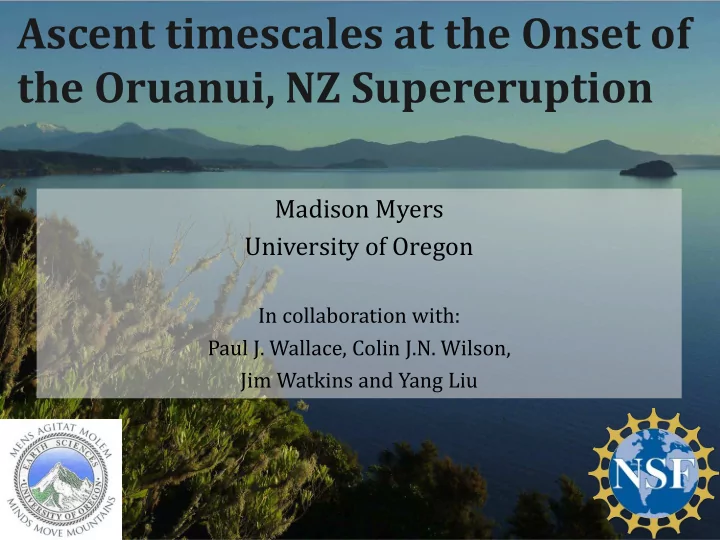

Ascent timescales at the Onset of the Oruanui, NZ Supereruption Madison Myers University of Oregon In collaboration with: Paul J. Wallace, Colin J.N. Wilson, Jim Watkins and Yang Liu
How are large volume eruptions triggered? Chamber Triggered Externally Triggered Much of our understanding for the initiation of large volume, caldera forming eruptions comes from modeling. Q: Would the timescales associated with various triggering mechanisms differ? e.g. Allen et al. 2012 ; Gregg et al. 2012, 2015; e.g Roche et al., 2000; Roche and Druitt 2001; de Silva and Gregg 2014 Carrichi et al. 2014; Malfait et al. 2014
Hypothesis: We can use volatiles concentrations and gradients (namely H 2 O and CO 2 ) to quantify the timescales of opening behavior. METHOD 1: H diffusion 100 μ m through quartz on timescales of days MI METHOD 2: H 2 O and CO 2 gradients formed in REs RE during final ascent; timescales of hours Shea et al. 2015 * All inclusions are crystal & bubble-free H 2 O + CO 2 : FTIR, University of Oregon
Three supereruptions with different characteristics Oruanui, NZ Oruanui, NZ Huckleberry Ridge Bishop Tuff Huckleberry Ridge 25.4 ka, 530 km 3 25.4 ka, 530 km 3 2.08 Ma, 2500 km 3 760 ka, 650 km 3 2.08 Ma, 2500 km 3 Significant time No significant time Significant time Subtle reworking in breaks observed; breaks between fall breaks between fall the fall deposit layers, the longest entire eruption layers, the longest indicates multiple inferred to have on the order of on the order of short time breaks taken ~6 days weeks to months weeks to months Wilson 2009 Wilson 2001 Wilson and Hildreth 1997 Huckleberry Ridge Bishop Tuff Do the differences observed in opening behavior reflect processes associated with eruption initiation?
Taupo Volcanic Zone (TVZ) Modern TVZ began around 2 Ma; predominantly andesite. At 1.6 Ma switched to dominantly rhyolitic volcanism (10,000 km 3 ). ~7 mm year, Wilson 2001 Acocella et al. 2003 Hamling et al. 2016 Southern extent of the Tonga-Kermadec arc. Cole et al. 2014
Oruanui Supereruption, NZ (25.4 ka, 530 km 3 ) Phase 3 Eruption broken into 10 phases; time gaps exist Phase 2 between 5 phases. Phase 1 Lateral injection of a foreign magma body Phase 3 The longest time gap is between phase 1 and phase 2, estimated to be on the order of several weeks. Allan et al. 2012
Are there timescale indications associated with the initial fall deposits of the Oruanui eruption, where rifting facilitated its initiation? METHOD 1: H diffusion 100 μ m through quartz on timescales of days MI METHOD 2: H 2 O and CO 2 gradients formed in REs RE during final ascent; timescales of hours * All inclusions are crystal & bubble-free
H 2 O and CO 2 Concentrations for Melt Inclusions ORUANUI BISHOP TUFF Increased scatter in H 2 O concentration from MIs (mostly F1 &F3) suggest effected by post-entrapment diffusive loss Melt Inclusions (n=95)
Diffusive Loss of H 2 O from entrapped MIs during magma ascent BISHOP TUFF Oruanui
Method I: Diffusion of H through Quartz Initial H 2 O Concentration –Highest melt inclusion values External H 2 O Concentration – Reentrant interior value Diffusion model (Qin et al. 1992, Cottrell et al. 2005) Diffusion Coefficient (Severs et al. 2007) Partition Coefficient (Qin et al. 1992) Size of inclusion and distance to rim
Timing of opening behavior: evidence for sluggish start Majority of melt inclusions require 1-5 days in contact with a lower H 2 O melt.
Different decompression histories into a single clast? Prolonged ascent, low overpressure in the system - perhaps indicative of external control?
Reentrants to calculate final ascent (H 2 O & CO 2 ) Area map made using the FTIR. Quartz grains picked and intersected to expose reentrant Best-fit function to evaluate error of During decompression, gas exsolves into bubbles. This drives fit for a given set of entered Converted Liu et al. (2007) H 2 O & CO 2 gradients in enclosed melt pockets (reentrants) that parameters using a chi-square fit fortran code into Matlab can be modeled to estimate decompression rate.
t=0 Gonnermann and Manga 2007 Assumptions input into the Liu et al. 2007 model: 1. Initial Conditions (Based on Melt Inclusion values or Innermost Reentrant Concentration ) 2. Initial exsolved gas 3. Fragmentation Threshold = 10 MPa (when quenching is assumed to have occurred) 4. Constant Decompression 5. Isothermal
Modeled H 2 O and CO 2 (when present) gradients from 26 reentrants dP/dt converted to ascent rate based on starting H 2 O & CO 2 and a crustal density of 2600 Kg/m 3
Ascent rate seems to increase most significantly in the Oruanui between Phase 1/Phase 2 (central vent) to Phase 3 (elongated source, higher eruptive volume)
Evidence that rifting strongly influenced the Oruanui initiation Time breaks in deposition. Foreign magma body laterally injected, facilitated through rifting H 2 O scatter in MIs- prolonged ascent, potentially low overpressure Slow final ascent rates for Phase 1 & 2, with increased rates associated with Phase 3 Allan et al. 2012
THANK YOU Research supported by NSF Grant EAR-1524824 and previously by Marsden Grant VUW0813.
Recommend
More recommend